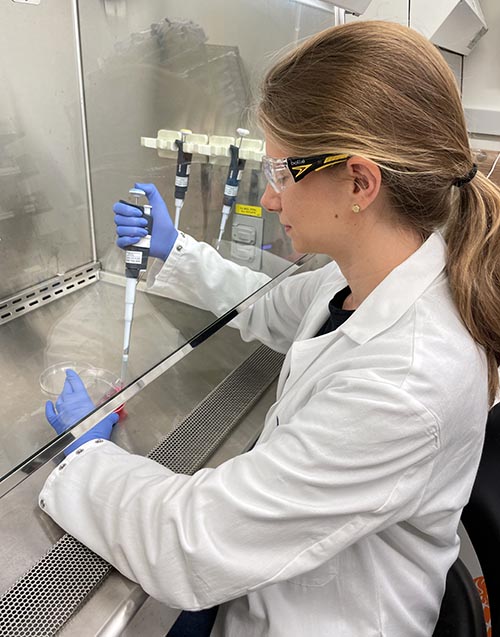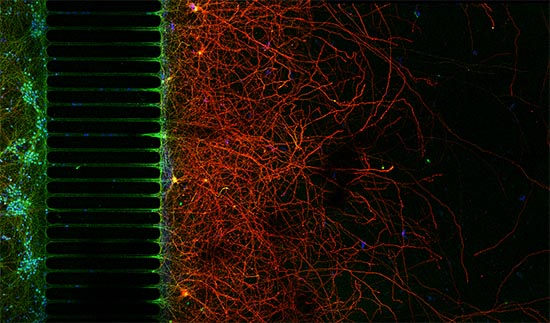Meet the Researchers: Cara Smith
Cara Smith recently completed her PhD in Biomedical Engineering and has been a member of SQI director Samuel Stupp’s laboratory since the fall of 2017. In the past few months, she presented a Rising Stars of SQI Lecture titled, “Supramolecular Netrin-1 Mimetic Nanofibers for Enhanced Neuron Growth and Functional Recovery Following Spinal Cord Injury,” and published a first-author paper in ACS Nano on the initial design and in vitro testing of these nanofibers. In this interview, Smith summarizes that research, describes her experience of working in the Stupp group, and shares her career aspirations.
How would you summarize the research that was the topic of your Rising Stars lecture and your recently published ACS Nano paper?
The general idea is that we’re trying to create a peptide amphiphile (PA) molecule that can be used in a scaffold system that will help with central nervous system repair — so either in the brain or the spinal cord. The ACS Nano paper describes this design process as well as some promising in vitro results.
We wanted to see if a protein mimetic — which contains a short sequence of amino acids, the building blocks of proteins — could have just as much bioactivity as a native protein. Some proteins have shown the ability to support neuron growth but these proteins have short half-lives, which limits their use as therapies.
Specifically, we were looking at netrin-1, which is a protein in the nervous system that can help control neuron behavior. It can help the axons grow and enter the injury site, so it can hopefully restore some of the downstream connections that get severed or damaged with injury.
In the paper, we were looking to see if the netrin-1 mimetic sequence was able to control neuron behavior and activate the neurons so they could be just as stimulated as they were with the native protein. The paper reported on our in vitro work with this system, and we’ve now followed up and applied it in an in vivo model of spinal cord injury and found that it had some beneficial effects.
Do any specific moments in this long project stand out? Was there a certain challenge that was difficult to overcome or a moment when you saw something exciting and realized you were on the right track?
One of the most exciting moments was when we started working with microfluidic devices. We had seen promising results already, but looking at the microfluidics device provided the starkest evidence that the netrin-1 PA was able to generate this neurite length response and get the neurites to grow just as well as the native protein. It was also really beautiful (image shown at right). I just remember talking to Zaida Alvarez (Smith’s mentor in the laboratory and a co-author on the ACS Nano paper) and her saying, “This experiment could be a whole figure in the paper.”
Can you describe the experience of working in the Stupp Lab and what the overall environment is like?
In addition to all the biology work in the Stupp Lab, there are a lot of different fields that you get exposed to, whether it’s energy materials, ferroelectricity, self-assembly concepts, and even just other areas of biology — like bone and cartilage regeneration.
It’s great for building knowledge, being exposed to new fields, and learning how to interpret things you might not otherwise see. Because the lab is so diverse, you have experts from many different areas, so if you have a question, it’s easy to find someone who can explain it to you in detail and explain it well. It’s been a really great learning environment.
How did you become interested in biomedical engineering in the first place, and what led you to focus on the central nervous system for these past several years?
I was always interested in doing something that would directly help people and I was fascinated with medicine. I would’ve been a doctor but I’m a little queasy around human blood so that wasn’t really an option. The next-best thing was moving into biomedical engineering.
Throughout grade school, high school, and undergraduate, I had excellent mentors who guided me to biomedical engineering because they thought it aligned with my interests. I really liked chasing scientific questions so they said I should go into engineering.
When I was an undergrad at Case Western Reserve University, I was able to do research in a lab that was looking at intracortical microelectrode implants and how the brain responds to those. At that point, I became very interested in the nervous system. I thought neurons were very interesting cells and they’re also beautiful to look at under the microscope, so there’s that added benefit.
That set me on this journey. I think the nervous system is so complex and there’s so much that we don’t know about it, that there are many avenues to explore.
You recently defended your thesis so you’re nearing the next step in your career. What are your future plans and aspirations?
I’m first pursuing a postdoctoral research position to prepare for an eventual career in academia. I want to stay in academia because I really enjoy teaching and mentoring. I ideally want to be Biomedical Engineering faculty. Whether that’s at a larger research institution or at a primary undergraduate institution where the focus is more on teaching, I don’t really know yet.
As an undergraduate and as a graduate student, I had a lot of opportunities to teach and mentor students in the lab. I get a lot out of it, I hope that they get a lot out of it, and I think it’s one of the most rewarding experiences to see people understand and get excited about science.
In general terms, what scientific topics are you interested in pursuing in your postdoc and going forward?
I definitely want to stay with targeting the nervous system, but in getting ready to eventually run my own laboratory, I want to pursue new materials to work with – seeing what else we can manipulate to create novel, complex things that can guide neuron regeneration or help the injury response. I’m also looking for more opportunities to teach and mentor in my next lab.
What are your hobbies outside of research?
My biggest hobby outside of lab is music. I’ve been playing the flute since I was in second grade, and I am now part of the Northwestern Medical Orchestra.
Our concert is in December and the theme is outer space, so we’re playing the “Star Wars” suite by John Williams and we’re also playing “Jupiter” by (Gustav) Holst as well as other exciting pieces. It’s been great to continue with music; I was lucky to find this group and it’s filled with a bunch of other medical professionals, graduate students, and medical students who work on the downtown campus.
